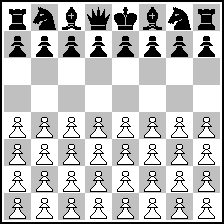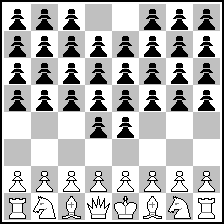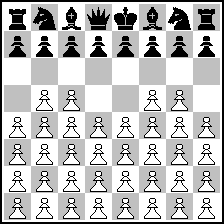
Website founded by
Milan Velimirović
in 2006
9:38 UTC


| |
MatPlus.Net  Forum Forum  General General  Analysis of positions with only one king on the board? Analysis of positions with only one king on the board? |
| |
|
|
|
|
You can only view this page!
| | | (1) Posted by Andrew Buchanan [Sunday, May 28, 2023 08:40] | Analysis of positions with only one king on the board?
Endgame positions with just one king on the board may be very rich. Has any analysis of simple positions done? Maybe even tablebases for small numbers of pieces?
There are some existing problems with no White king. For example, h#7 (me & Geoff Foster - TPS 2020). But the question here concerns endgame studies.
 (= 1+4 ) (= 1+4 )
2 The Problemist Supplement 169, p. 120, 11/2020
h#7 Illegal position
Such positions are illegal, but there's no problem playing forwards. Only one side can be mated, but imbalance of force is a part of many fascinating legal endgames. They may also occur in e.g. long games of Horde Chess.
I emailed chess theorist, John Beasley, who seemed the person most likely to have explored this area, if anyone had. But he has no idea.
Thanks,
Andrew
| | | (2) Posted by Kevin Begley [Sunday, May 28, 2023 21:53] |
Good question.
I am aware of no EGTB which provides DTM/DTC information in a position lacking a King (or with a pawn on its 1st rank).
Somebody may have created an EGTB for Dunsany's Chess, Horde Chess, and/or the Horde Variant.
Of course, even if that's the case, you may encounter extraneous positions in the table (simple example: you may not want a table with pawns on the first rank for one side), and gaping holes in the table (simple example: you may want pawns on the first rank for both sides).
Note that you're talking about an EGTB not for Horde Chess (which, as originally proposed by Filip Rachunek in 2002, has no black King), but for the Horde Variant (which has become more popular, thanks to Lichess and Chess.com).
I seem to recall reading that both Horde Chess (the original version) and Dunsany's Chess are considered a win for [edit] the side with a King (the all-pawn army loses against a prepared opponent).
The Horde Variant is a second attempt to achieve a dynamic balance (and I seem to recall reading that's not considered sufficient either).
I highly doubt any of these variants are even weakly solved, but it's very possible an EGTB exists -- best to consult enthusiasts who actively play these variants.
Note: there are some blogs about these conditions (e.g., https://hordechessblog.com), and there are several sites where you can play them.
It's not terribly difficult to write your own EGTB generator, but you'll need a whole lot of time and memory before you can begin mining the table for gems.
I am of the opinion that variant endgame tables plus a weak AI (with theme recognition plus some basic comparison capacity) is the most efficient way to demonstrate the potential of a fully automated chess problem composer. You could do far better with a skilled composer using such an AI as a mining tool (in a custom EGTB covering a smartly selected stipulation/condition combination).
If you have the memory, you could generate your variant EGTB with capacity to mine directmates, selfmates, helpmates, and helpstalemates (maybe even cover stalemates and various types of series-movers). The possibilities are endless.
My guess is that it's best to look for a relatively unexplored variant with rich possibilities for specific themes achieved in highly economical settings, and make this your niche.
To this end, Dunsany's Chess (and variants) would not be my first choice.
Dunsany's Chess
 (= 32+16 ) (= 32+16 )
Horde Chess
 (= 16+32 ) (= 16+32 )
Horde Variant
 (= 36+16 ) (= 36+16 )
| |
No more posts |
MatPlus.Net  Forum Forum  General General  Analysis of positions with only one king on the board? Analysis of positions with only one king on the board? |
|
|
|
 ISC 2025
ISC 2025 Forum
Forum  General
General  Analysis of positions with only one king on the board?
Analysis of positions with only one king on the board? 
